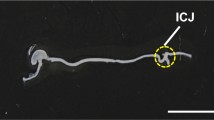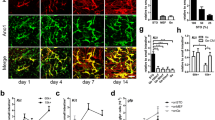Summary
The extracellular matrix influences organogenesis by modulating cell behavior. In humans, collagen is the major matrix constituent of the adult intestinal wall and is synthesized by smooth muscle cells. The objective of the current study was to examine collagen production by fetal human intestinal smooth muscle cells isolated during intestinal morphogenesis. Techniques were developed for the isolation and culture of human fetal intestinal smooth muscle cells. The cultured cells were confirmed as muscle by immunohistochemical stains for cytoskeletal filaments and documentation of contractile behavior. In culture, these cells stained for mesenchymal and muscle cytoskeletal proteins: vimentin, actin, and desmin, and did not stain for neural or epithelial markers. The muscle cells contracted in response to acetylcholine, in contrast to human fetal dermal fibroblasts which did not contract appreciably. Collagen production was assayed by the uptake of [3H]-proline into collagenase-digestible protein. Collagen production was greatest at 11 weeks gestation, the youngest age studied. By 20 weeks gestation, collagen production had decreased to adult levels. However, when compared to another matrix-producing fetal mesenchymal cell, the dermal fibroblast, intestinal smooth muscle cells produced twice as much collagen. Collagen types were determined by polyacrylamide slab gel electrophoresis. Smooth muscle cells predominantly produced types I and III collagen α chains. Therefore, collagen production is a significant function of human fetal intestinal smooth muscle cells, and probably plays a major role in the development of intestinal structure. The in vitro model presented here provides a means of studying the regulation of this collagen production throughout intestinal organogenesis.
Similar content being viewed by others
References
Bernfield M, Banerjee SD, Koda JA, Rapraeger AC (1984) Remodeling of the basement membrane as a mechanism of morphogenetic tissue interaction. In: Trelstad RL (ed) The role of the extracellular matrix in development. Liss, New York, pp 545–572
Bitar KN, Makhlouf GM (1986) Measurement of function in isolated single smooth muscle cells. Am J Physiol 250 (Gastrointest, Liver Physiol 13):G357-G360
Boreus LO (1968) Demonstration of a receptor reserve for acetylcholine in the human fetus. Acta Physiol Scand 72:194–199
Clark CC, Richards CF (1985) Isolation and partial characterization of precursors to minor cartilage collagens. Coll Relat Res 5:205–233
Diegelmann RF, Peterkofsky B (1972) Collagen biosynthesis during connective tissue development in chick embryo. Dev Biol 28:443–453
Diegelmann RF, Bryson GR, Flood LC, Graham MF (1990) A microassay to quantitate collagen synthesis by cells in culture. Anal Biochem 186:296–300
Ekblom P (1984) Basement membrane proteins and growth factors in kidney differentiation. In:Trelstad RL (ed) The role of the extracellular matrix in development. Liss, New York, pp 173–206
Epstein EH (1974) [Alpha 1 (III)]3 human skin collagen. J Biol Chem 249:3225–3231
Form DM, Pratt BM, Madri JA (1986) Endothelial cell proliferation during angiogenesis in vitro modulation by basement membrane components. Lab Invest 55:521–530
Furcht LT (1986) Critical factors controlling angiogenesis: cell products, cell matrix, and growth factors. Lab Invest 55:505–509
Gerstenfeld LC, Crawford CR, Boedtker H, Doty P (1984) Expression of type I and III collagen genes during differentiation of embryonic chicken myoblasts in culture. Mol Cell Biol 4:1483–1492
Gospadarowicz D, Ferrara N, Schweigerer L, Neafield G (1981) Structural characterization and biological functions of fibroblast growth factor. Endocrin Rev 8:95–108
Graham MF, Diegelmann RF, Elson CO, Bitar KN, Ehrlich HP (1984) Isolation and culture of human intestinal smooth muscle cells. Proc Soc Exp Biol Med 176:503–507
Graham MF, Drucker DEM, Diegelmann RF, Elson CO (1987) Collagen synthesis by human intestinal smooth muscle cells in culture. Gastro 92:400–5
Graham MF, Diegelmann RF, Elson CO, Lindblad WJ, Gotschalk N, Gay S, Gay R (1988) Collagen content and types in the intestinal strictures of Crohn's disease. Gastroenterology 94:257–265
Haffen K, Kedinger M, Simon-Assmann P (1983) Inductive properties of fibroblastic cell cultures derived from rat intestinal mucosa on epithelial differentiation. Differentiation 23:226–233
Haffen K, Kedinger M, Simon-Assmann P (1987) Mesenchyme-dependent differentiation of epithelial progenitor cells in the gut. J Pediatr Gastroenterol Nutr 6:14–23
Haffen K, Kedinger M, Simon-Assmann P (1989) Cell contact dependent regulation of enterocyte differentiation. In: Lebenthal E (ed) Human gastrointestinal development. Raven Press, New York, pp 19–39
Hart SL (1971) Adrenoreceptors in the human fetal intestine. Br J Pharmacol 41:567–569
Hart SL (1975) The effect of drugs on human fetal intestine. W Afr J Pharmacol Drug Res 2:57–64
Hauschka SD, Konigsberg IR (1966) The influence of collagen on the development of muscle clones. Proc Natl Acad Sci USA 55:119–126
Hauschka SK, White NK (1972) In: Barker BQ, Prozybyiski RJ, Van der Meulen JP, Victor M (eds) Research in muscle development and muscle spindle. Excerpta Medica, Amsterdam, pp 53–71
Hosick HL, Inaguma Y, Kusakabe M, Sakakura T (1988) Morphogenesis of mouse mammary epithelium in vivo in response to biomatrix prepared from a stimulatory fetal mesenchyme. Dev Growth Differ 30:229–240
Hsu S-M, Raine L, Fanger H (1981) Use of the avidin-biotinperoxidase complex (ABC) in immunoperoxidase techniques: a comparison between ABC and unlabeled antibody (PAP) procedures. J Histochem Cytochem 29:577–580
Kedinger M, Simon-Assmann PM, Lacroix B, Marser A, Hauri HP, Haffen K (1986) Fetal gut mesenchyme induces differentiation of cultured intestinal endodermal and crypt cells. Dev Biol 113:474–483
Labarca C, Paigen K (1980) A simple, rapid, and sensitive DNA assay procedure. Anal Biochem 102:344
Lacovara J, Cramer EB, Quigley JP (1984) Fibronectin enhancement of directed migration of B16 melanoma cells. Cancer Res 44:1657
Lacroix B, Wolff-Queno M, Haffen K (1984a) Early human hand morphology: an estimation of fetal age. Early Hum Dev 9:127–136
Lacroix B, Kedinger M, Simon-Assmann P, Haffen K (1984b) Effects of human fetal gastroenteric mesenchymal cells on some developmental aspects of animal gut endoderm. Differentiation 28:129–135
Laemmli UK (1970) Cleavage of structural proteins during the assembly of the head of bacteriophage T4. Nature 227:680–685
Leibovitch SA, Hillion J, Leibovich MP, Guillier M, Schmitz A, Harel J (1986) Expression of extracellular matrix genes in relation to myogenesis and neoplastic transformation. Exp Cell Res 166:526–534
McCarthy JB, Palm SL, Furcht LT (1986) Migration by haptotaxis of a schwann cell tumor line to the basement membrane glycoprotein laminin. J Cell Biol 102:179
McMurphy DM, Boreus LO (1968) Pharmacology of the human fetus: adrenergic receptor function in the small intestine. Biol Neonate 13:325–339
Montesano R, Orci L, Vassalli P (1983) In vitro rapid organization of endothelial cells into capillary-like networks is promoted by collagen matrices. J Cell Biol 97:1648–1652
Nabeshima K, Kataoka H, Koono M (1986) Enhanced migration of tumor cells in response to collagen degradation products and tumor cell collagenolytic activity. Invasion Metastasis 6:270–286
Patten BM (1953) Human Embryology. McGraw-Hill, New York, pp 74, 98, 117,235
Peterkofsky B, Diegelmann RF (1971) The use of a mixture of proteinase-free collagenase for the specific assay of radioactive collagen in the presence of other proteins. Biochemistry 10:988–994
Sandberg M, Makela JK, Multimaki P, Vuorio T, Vuorio E (1989) Construction of a human proalpha 1(III) collagen cDNA clone and localization of type III collagen expression in human fetal tissues. Matrix 9:82–91
Simon-Assmann P, Kedinger M, Haffen K (1986) Immunocytochemical localization of extracellular-matrix proteins in relation to rat intestinal morphogenesis. Differentiation 32:59–66
Simon-Assmann P, Bouziges F, Freund JN, Perrin-Schmitt F, Kedinger M (1990) Type IV collagen mRNA accumulates in the mesenchymal compartment at early stages of murine developing intestine. J Cell Biol 110:849–857
Smith LT, Holbrook KA, Byers PH (1982) Structure of the dermal matrix during development and in the adult. J Invest Dermatol 79:93s-104s
Sykes B, Puddle B, Francis M, Smith R (1976) The estimation of two collagens from human dermis by interrupted gel electrophoresis. Biochem Biophys Res Commun 72:1472–1480
Thesleff I, Barrach HJ, Foidart JM, Vaheri A, Pratt RM, Martin GR (1981) Changes in the distribution of type IV collagen, laminin, proteoglycan and fibronectin during mouse tooth development.
Author information
Authors and Affiliations
Rights and permissions
About this article
Cite this article
Perr, H.A., Grider, J.R., Mills, A.S. et al. Collagen production by human smooth muscle cells isolated during intestinal organogenesis. Anat Embryol 185, 517–527 (1992). https://doi.org/10.1007/BF00185612
Accepted:
Issue Date:
DOI: https://doi.org/10.1007/BF00185612




